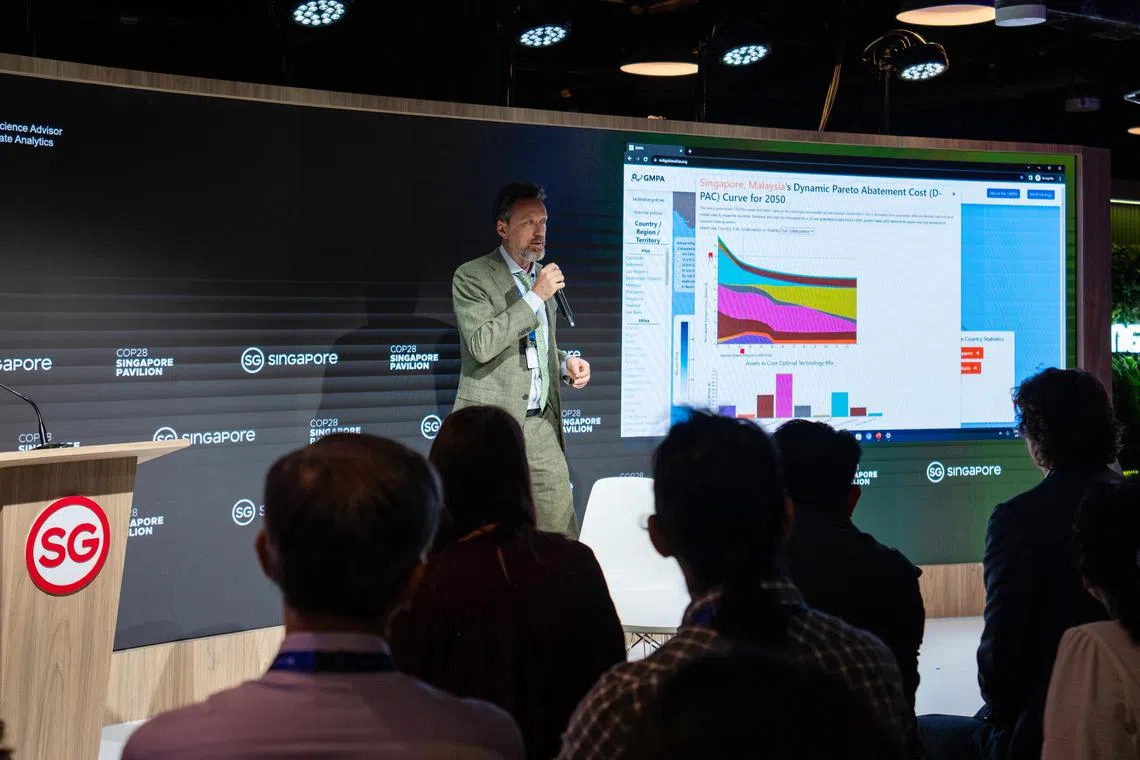‘Mitigation atlas’ launched at COP28 to help countries collaborate on decarbonisation
Sign up now: Get ST's newsletters delivered to your inbox

Dr Michiel Schaeffer, the lead science adviser at Climate Analytics, launching the Global Mitigation Potential Atlas at the Singapore Pavilion on Nov 30, 2023.
PHOTO: MSE
Follow topic:
DUBAI - A Web-based “mitigation atlas” has been launched to highlight ways for countries to cut greenhouse gas emissions both domestically or through international collaboration.
The Global Mitigation Potential Atlas (GMPA), created by an international consortium of researchers, was launched on Nov 30 at the Singapore Pavilion on the sidelines of the United Nations COP28 climate conference in Dubai.
Essentially a map-based database, it identifies various countries’ mitigation potential – their ability to reduce global greenhouse gas emissions by taking certain measures and actions.
It was launched with eight South-east Asian pilot countries, and includes emissions data on the power sector and hard-to-decarbonise industries like steel and cement.
The data will be kept updated, and the GMPA will eventually evolve into an international online database on mitigation data and potential around the world.
The atlas was co-developed by non-profit organisation Climate Analytics, the Agency for Science, Technology and Research (A*Star), the Lee Kuan Yew School of Public Policy, and the Institute for Essential Services Reform, an Indonesian non-governmental organisation.
The researchers spent a year aggregating country-specific emissions data, the cost of renewable energy, and the cost and capability for each country to decarbonise – with data harmonised for consistency to create a centralised platform, as various countries calculate their emissions differently.
For instance, Singapore currently relies on at least 95 per cent natural gas, with a small proportion of solar power and other energy sources. According to the GMPA, if no action is taken to decarbonise the power sector, the country’s projected greenhouse gas emissions by 2050 could go up to 37.9 million tonnes of carbon dioxide (CO2) equivalent a year.
Using only domestic measures such as maximising Singapore’s solar potential and developing smaller natural gas power plants, Singapore would be able to mitigate only 3.03 million tonnes of CO2 equivalent a year. The average mitigation cost of doing so would be around US$50 (S$66) per tonne of CO2 equivalent.
Based on its modelling, the GMPA projects that domestic measures alone will be insufficient for Singapore’s power sectors and hard-to-decarbonise industries to achieve net-zero emissions by 2050.
However, if Singapore were to collaborate with its neighbours, its net-zero ambitions could be met through green electricity imports such as green ammonia and solar, along with the help of battery and ammonia storage technologies.
The atlas shows how collaborations with different combinations of countries could also yield varying results.
For instance, if Singapore and Indonesia were to collaborate, an additional 61 million tonnes of CO2 equivalent can be mitigated a year at US$20 per tonne of CO2 equivalent beyond the current baseline cost.
Singapore could invest in a solar farm in Indonesia for electricity imports, which would benefit both countries in cutting their greenhouse gas emissions.
This mitigation potential could be increased by a further 19 million tonnes of CO2 equivalent a year if there were a three-way collaboration between Singapore, Indonesia and Malaysia. This could have a total additional mitigation potential of 80 million tonnes of CO2 a year, at the same US$20 per tonne of CO2 equivalent additional cost.
Dr Aniq Ahsan, a scientist at A*Star who was involved in the project, told The Straits Times that the mitigation atlas demonstrates how a multinational Asean grid would help to reduce emissions across different countries, while also reducing the costs of doing so.
“Our data also shows, for instance, that ammonia storage technologies should only be utilised closer to 2050, as such tech is still extremely costly, and it would be more economically viable to leverage them later.
“In the nearer term, power sector imports would be more economically viable, even while taking into consideration the costs of building power lines and subsea cables between countries,” he noted.
Dr Michiel Schaeffer, the lead science adviser at Climate Analytics, said that a key objective of the atlas is to channel more finance, capacity building and tech solutions for emissions mitigation in developing countries by fostering international cooperation.
The team also hopes to incorporate all greenhouse-gas emitting sectors in South-east Asia to have a more comprehensive overview of the international collaboration needed to get the region to net-zero.
Other co-benefits of making the green shift, such as less air pollution and improved public health from the use of cleaner energy, could also be incorporated into the atlas to ensure more robust policy decisions.
Eventually, the team hopes to roll out the atlas to other regions, such as East Africa and Southern Africa.
Hopefully, this could allow countries to make “unexpected” partnerships, and decarbonise their economies as quickly as possible, said Dr Ahsan.


